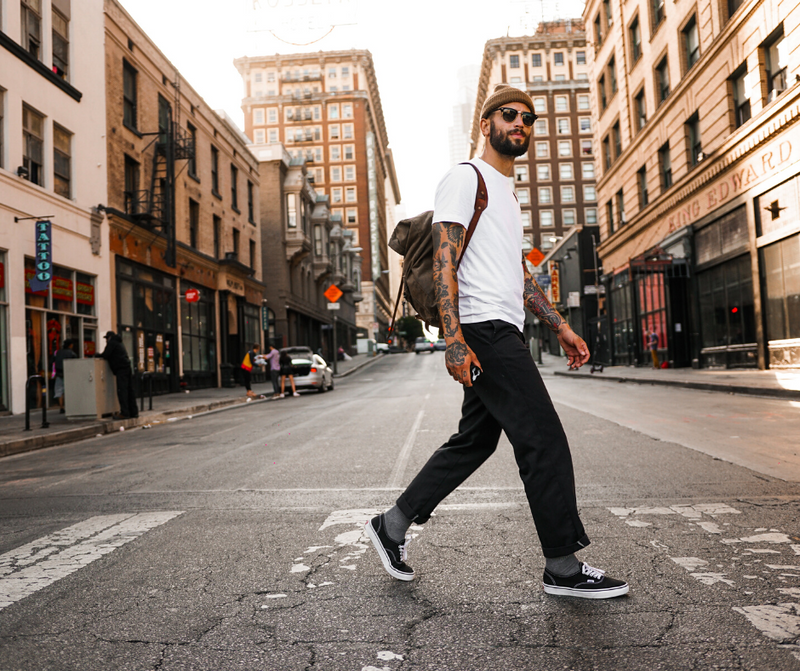This article is dedicated to everyone who is not naturally super excited about daily workouts. It is for me - and those - who need some tricks to implement fitness into daily life, to understand that motivation is a myth and that hobbies can be fun ways of workouts, too.
Traveling around the world can be intense. Traveling around the world while working full-time remotely can be intense and stressful. Doing both with the aim to stay fit at the same time can be really challenging.
The human brain likes routine and habits because it requires less energy to produce new neuro-connections which are done as soon as we do something new or unexpected. If we always do what we have always done, we will always do the same. My friend calls people who do the same routine every day, every day of the week, and this for months and months and months, mental fatties.
Combining living in old repetitive patterns with long-hour workdays and complicated traveling planning during COVID, it can be tough at times to keep up with physical fitness.
I gathered some ideas on how to keep up with your physical fitness which is suitable while traveling. But first, what about laziness, procrastination, and notorious postponing habits?
🌱 Travel health insurance for digital nomads
⏱ #1 The 5-second rule
Have a look and search for a fitness YouTube channel that appeals to you, subscribe to it, and set a fixed time period in your calendar, e.g. Monday to Friday at 7 am. Prepare your outfit already the evening before, including headphones, water bottle, and towel, to minimize the risk to cancel.
In the morning, do not lie in bed and think about the impact of one canceled morning workout, your to-do list, your workload, the client call at 10 am, or that you are actually hungry. As soon as you start thinking about all the reasons why you should not work out, you set your brain on the thought of being okay with laziness and procrastination.
Decisions must be taken within 5 seconds. The 5-second rule is a cognitive-behavioral technique that helps with procrastination. The trick is to commit to a task, this is already done when adding the workout to your calendar, and start doing the task before 5 seconds. This gives your brain no time to weigh up the pros and cons which normally leads to avoiding the task.
“The 5 Second Rule is simple. If you have an instinct to act on a goal, you must physically move within 5 seconds or your brain will kill it. The moment you feel an instinct or a desire to act on a goal or a commitment, use the Rule.
When you feel yourself hesitate before doing something that you know you should do, count 5-4-3-2-1-GO and move towards action.” - Mel Robbins
🏃🏻♂️ #2 Universal workout
Depending on your preference and your travel schedule, it might be worth trying to find a universal workout, you can do anywhere in the world that doesn't require equipment or gym memberships. It should be doable in any climate and with limited space available.
If you don't want to make much time available for your daily workout, and you do want an instructor telling you what to do, try out the 7-minute workout.
YouTube channels to check out for your self-organized daily workout routine:
Action step: Search for a YouTube channel, find a good playlist, for example, a 7-days challenge or 30-day challenge, add the workout to your calendar, and apply the 5-second rule if you suffer from procrastination.
🧘🏽♂️ #3 Universal Yoga
If you are more into yoga, check out YouTube channels for your preferred online do-it-yourself yoga class. My favorite yoga channels are the following:
- Boho Beautiful app
- Boho Beautiful Yoga
- Yoga with Allie Van Fossen
- Yoga with Adrienne
- Mady Morrison (German)
Action step: Search for a YouTube channel, find a good playlist, for example, a 7-days challenge or 30-day challenge, add the yoga classes to your calendar, and apply the 5-second rule if you suffer from procrastination.
🏋🏼 #4 Join local fitness groups
Maybe you are not into self-organized YouTube workouts and yoga classes and you prefer to go to a gym or class instead and work out together with other people.
Many travel destinations provide local gyms. Join on a daily, weekly, or monthly membership and train with others.
Check out the local Facebook groups, including the expat groups, the local events groups, and the local digital nomad groups for fitness groups you can leisurely join. Maybe there is a hiking group, a cycling group, a yoga group, or a runners group at your destination. Training with others is a great accountability boost, especially when you join regularly.
Action step: Search for a local fitness class, join the group online, ask for events, and training schedules, add the workout to your calendar and apply the 5-second rule if you suffer from procrastination.
👟 #5 Integrate fitness into your daily life
Another easy way to increase your fitness level is by integrating fitness into your daily life and making it a habit wherever you go. At the airport, after you checked in your luggage, of course, take the stairs and skip escalators and elevators. In shopping malls and museums, take the stairs and apply this habit to your accommodation as well.
Instead of taking Uber, the metro, or your scooter, walk every distance shorter than 2 km and make walking a habit too. I recently discovered that my phone - so that means yours too, comes with a step count. I wasn't aware of it. But I check every evening the distance I walked today and I try to keep it to a minimum of 5 km per day, an average of 9 km per day, and on the weekends or a day off work, I try to walk 15 km throughout the day. You are probably aware of this function of your phone, so just make use of it.
🏛 #6 Combine walking with sightseeing
Check the sightseeing points you want to visit on Google Maps and create your own sightseeing tour and if possible walk all of them or the majority. Or take the bicycle if the distances are too long.
I remember that I would visit Saigon for many years and take a Grab everywhere I went because it was cheap and quick, and the waiting time was always less than 2 minutes. By having this habit, I missed the opportunity to get to know the city and to navigate myself through the metropolitan jungle which always includes the find of great coffee shops, and restaurants I missed as I just rushed on a Grab bike from one part of the city to the other. When I met my partner, he insisted on walking everywhere we'd go, also if that meant walking from the D1 district to Thao Dien (D2 district) which is a 45-minute walk including partially passing ugly and dirty construction sites. However, I got to know Saigon in great detail and within weeks, we discovered an amazing amount of coffee shops, and restaurants, we would have never found. Walking in Saigon gave me a whole new perspective of the city and it connected all the little mosaic pieces into one big picture. The same big picture I now have of Manhattan, Singapore, and Bangkok.
👗 #7 Learn how to dance
A fun way to integrate fitness into your daily life is by joining a dance class. Have you ever danced Rock'n'Roll for one hour? Or Lindy Hop? Or Salsa? Wow, that is not just a great workout, it also introduces you to local cultures, and you get to know other people at the same time.
I am a Lindy Hop dancer, not a professional but I would say it is a hobby of mine. Lindy Hop is a form of Swing dance, the big sister of Rock'n'Roll and you dance to music from Nina Simon, Benny Goodman, Louis Armstrong, and Ella Fitzgerald. I love the Golden Twenties and Big Band era.
When I learned about Lindy Hop about a decade ago, I thought it is a niche hobby only available in big cities in Europe or the USA. How wrong I was! I found Lindy Hop dance groups in almost every country I traveled to, from Vietnam to Singapore, to Malaysia, to Mexico City, or to Bali. And if you are into Salsa, I bet the salsa scene is even bigger than the Swing dance scene.
🚦 #8 Don't wait for the perfect setup
This applies only to perfectionists - like me. Sometimes I think I am a bit OCD in terms of the cleanliness and structure of my environment. For example, I thought I can only work, when my room is sparkling clean, all laundry is done, all dishes are washed, and my desk is empty. The same applied to workouts. I had to have my perfect spot, the perfect time of the day, and so on. This wasn't a big problem when I lived as an expat in my long-term apartment in Vietnam, not having too many changes in my daily work routine. Now, as I am traveling and working at the same time, I had to face this habit and get used to the fact that short-term hotel rooms, Airbnb apartments, new locations, and neighborhoods will never give me the perfect setup.
I am fine now with less perfection. Sometimes I do yoga in hotel parking lots, as there is no other space I can do it. Often, there is a lot of noise around, like construction noise or music, which could easily distract me. I use my headphones now and try to ignore the noise. And sometimes there is not enough space in my room but it is cold outside which is another reason for me to postpone the workout. Once I realized that I will rarely find the perfect yoga spot and that noise, temperature, or space will be limiting factors for me as a traveling yogini, I need to decide what is more important, to actually do the class every day or do the class once a week in the perfect setup? My goal for doing yoga for me is to do yoga. To move my body, work out, train muscles, improve asanas, and hold postures for a longer time period. And these goals are independent of the perfect setup - I have realized now.
🚧 #9 Don't wait for your motivation
A mistake I made is to wait until the motivation kicks in. As I am not super much into sports, e.g. gym workouts or running, I would always find reasons why today is a good day to skip the workout. Especially when the perfect setup wasn't given as mentioned above.
I learned in the past years that motivation is a myth. Sometimes, I wake up and I am really motivated to workout, or to work a full day, although I am within walking distance of a tropical beach which is very inviting to procrastinate, postpone and skip tasks. I am not motivated to work out. Sorry. But I am motivated to become a better human being, to grow this habit of doing it every day, and to train my lazy me inside to shut up. I train my brain to be disciplined but I don't wait for the motivation to kick in. There are days when I just don't feel like working out. But once I skipped one day, it is easy to skip the next day too. And on day 3 it starts to affect my mood, and I am disappointed with myself. We all have these evil cycles.
Once I understood that I don't need to wait to be motivated to do something, but I need to train discipline, I applied the 5-second rule and I can say I have improved a lot. Read more about the motivation myth here.
🤓 #10 Accountability buddy
It would be helpful to set up an accountability structure. This can be done yourself by checking in every week, on how many of the scheduled workouts you actually did and how much you have walked on average per day.
If you need a human being, maybe one of your friends or family members can check in with you every week and simply ask you to report. This is not to tease you but to get you in the habit of thinking about fitness and to help you to improve from week to week.
I hope you found some tips on how to work out while traveling. If you have more ideas you want me to add, please tell me here.









